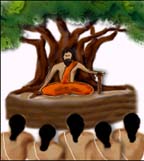|
|
Carnatic
music has a very ancient and traditional background. The very word
“Carnatic” means traditional or ancient. However, the application of the
term Carnatic to this form of music is more recent than the music itself!
Here we discuss the elements of change and continuity in this traditional
form of classical music in India. These include the preservation and
propagation of the art-form from one generation to the other over a long
period of time, along with the cultural, social, regional and religious
practices of the country and its influence on the system. There has been a
quite strict adherence to the traditional values of the art, but ample room
has been found for innovations within the traditional framework.
Educational Set-up
|
The Gurukula
System:
The traditional method of teaching in India was the Gurukula
system (Guru
- Teacher,
Kula
- Family). The Gurukula system involved living with the teacher,
as if the student were a part of the family. Education was a dynamic
process, imbibed through living, travelling with and completely
associating oneself with the Guru (teacher).
The Guru, according to Indian tradition is equated to God
and was considered primary for the learning of any
art. In other words, teachers were always held
in high esteem. The relationship
between the teacher and the student (sishya) is known as Guru-sishya
Parampara. |
 |
The art was handed down from the teacher to the student through direct oral
instruction. This form of imparting the education has been a special
tradition in Carnatic music.
Certain scholars make a slight distinction
between Gurukula
system and Guru-sishya Parampara,
though the mode of learning, on principle, was almost the same. The
difference is that the Gurukula system
can be compared to the present day residence or boarding school. Thus, a
group of students lived with and studied under one single Guru, till
they completed their education. It may be noted here that from Vedic times,
any art form, including music, was taught through this method.
The Guru-sishya
Parampara
is considered as learning on a one-to-one basis (the teacher
and a single student), the student being a part of the teacher’s household
and learning without any time bindings, as per the teacher’s convenience.
The Gurukula system
was an effective medium to preserve this traditional art form without losing
the values for this many generations. The family tradition of imparting
education was also prevalent and this trait was also responsible in
preserving this music system. The student had the advantage of being in the
presence of the Guru all the time, along with the freedom on the part
of the Guru to teach according to individual talents and capacities. More
importantly, through constant observation, a good student could imbibe the
central features of the Guru’s music and his personality. The reverence for
the Guru and strict obedience were part of the Gurukula tradition.
Until recently (~ 1930-40), the Gurukula system was hailed as the
most useful system for music education, also because one pursued the art
full-time and had the scope to do so. Several prominent musicians and
composers have been a product of this system.
|